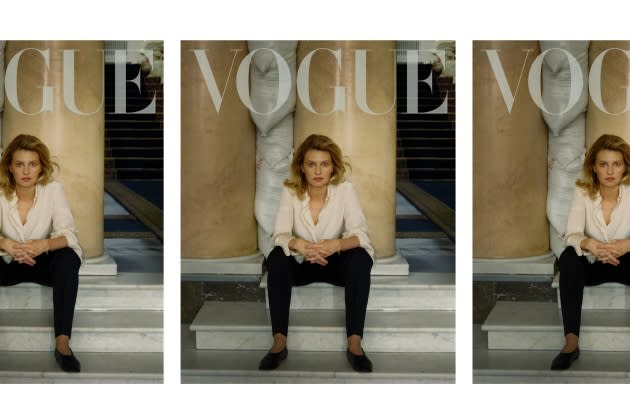Vogue and Annie Leibovitz Under Fire for First Lady Cover Story
- Oops!Something went wrong.Please try again later.
- Oops!Something went wrong.Please try again later.
- Oops!Something went wrong.Please try again later.

TROUBLED TIMES: With the war in Ukraine in its fifth month, Vogue’s decision to feature First Lady Olena Zelenska on a digital cover and a multipage spread with President Volodymyr Zelensky has kicked up a firestorm of controversy.
Another point of contention for some social media critics was the role of celebrity photographer Annie Leibovitz.
More from WWD
The cover image features a serious-looking Zelenska, seated on a step inside of the presidential compound with her hands entwined wearing an ivory-colored blouse with her sleeves rolled up, black pants and flats. The top line reads “Portrait of Bravery: Ukraine’s First Lady Olena Zelenska,” with the lettering of “Ukraine” emboldened in the same shade of blue that is used in the country’s flag. A post of the cover image on Leibovitz’s Instagram had 47,813 likes and 1,523 comments that were largely complimentary.
However, as of Thursday at 5 p.m. EST, a post of the first couple seated holding hands had 89,952 likes and 3,445 comments on Leibovitz’s Instagram. A quick scroll of the comments showed many were largely derogatory. Some social media critics posted remarks like “What kind of propaganda is this,” “Oscars invitations, Vogue shoots, war…crazy times we live in!” “While their people die…they pose for a photo shoot…” “Incredibly tasteless” and “Yeah cool war, let us make photo session yeah.” Others posted more favorably including “Thank you for supporting Ukraine. You are a genius in the world of photography,” and “Talented and powerful.”
While the media and social media pundits seized on the story Thursday, Leibovitz and Condé Nast remained silent when asked about the photo shoot by WWD. The controversy has fired up well in advance of the October edition’s release date of Sept. 20.
Leibovitz was on assignment Thursday and was not available to comment, according to Karen Mulligan, her longtime studio manager.
Executives at Condé Nast declined comment Thursday.
At 4,700 words, the extensive feature by Rachel Donadio takes issue with the ongoing war and highlights Zelenska’s role in rallying support for her country. Just last week, she visited the U.S. Capitol to address members of Congress and called on the U.S. and NATO to provide Ukraine with air defense systems for its efforts to offset the Russian invasion. After reportedly hiding out with her children for the first two months of the Russian invasion, Zelenska has taken a more public role in recent weeks. Her U.S. trip included face time with President Joe Biden and First Lady Jill Biden, Secretary of State Antony Blinken and the U.S. Agency for International Development’s Samantha Power.
As of Sunday, the Russian Federation’s armed attack against Ukraine had resulted in 12,272 civilian casualties — 5,237 fatalities and 7,035 injuries.
While the profile of the first couple was said to be meant to remind people of the stakes of war, many could argue that much of the Western world is aware of the onslaught underway throughout Ukraine. More than 12 million people have exited the country since Russian soldiers invaded in late February.
In a tweet on Tuesday, Donadio said she traveled to Kyiv this month for the profile and described it as “one of the most moving and memorable assignments of my career.”
However frivolous, tone-deaf or unnecessary some might consider Vogue’s assessment of the upheaval in Ukraine to be, the concept of women’s magazines, including fashion ones, covering wars and times of conflict is well engrained. Vogue’s portrayal of Zelenska is miles away from a typical fashion shoot.
In 1916, when World War I made delivering Vogue impossible to the Old World, printing of the magazine was started in England. That decision turned out to be successful, and in 1920, the first issue of French Vogue was released.
During World Wars I and II, women’s magazines depicted women contributing through first aid and other relief efforts. The magazines also highlighted such wartime shortages as clothing rationing. Esteemed fashion photographers like Horst P. Horst captured those images. In March of 1943 the then-undiscovered Lauren Bacall appeared on the cover of Harper’s Bazaar in front of a glass door imprinted with “American Red Cross Blood Donor Services” with what appears to be a nurse behind it.
Model-turned-photographer Lee Miller worked for British Vogue during World War II. When the war broke out, her initial offer to shoot for the magazine was rejected, and Miller was taken on as a studio assistant. As Vogue’s male photographers left on war service, she took on a good deal of the publication’s fashion and lifestyle coverage. Following the conscription of women in December 1941, Miller’s photography included series on women who were contributing to the war efforts in different ways.
But in these media-overload and social media-laden times, millions are already well aware of the destruction and suffering that is impacting Ukraine. Trinity College professor and visual artist Pablo Delano declined comment regarding Vogue, explaining that would be a “lose-lose proposition.” He said he learned that lesson after commenting about “beautifully styled gorgeous ballet dancers striking dramatic poses amidst the destruction” caused by Hurricane Maria in Puerto Rico. The images were supposed to represent the resilience of the Puerto Rican people, but some felt they were tasteless and tone-deaf, Delano said Thursday.
Best of WWD
Sign up for WWD's Newsletter. For the latest news, follow us on Twitter, Facebook, and Instagram.
